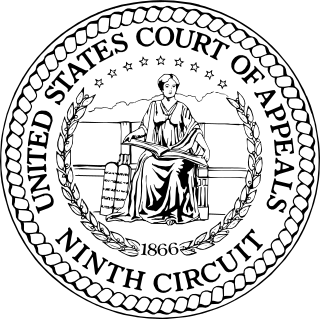 W
WUnited States v. Shi, 525 F.3d 709 is a case involving piracy on the high seas. The case held that United States could try foreign nationals on foreign-flagged vessels for crimes committed on the high seas, outside the territory of the United States.
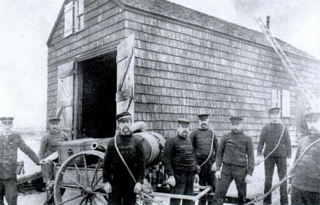 W
WThis page contains a list of United States Coast Guard stations in the United States within the United States Coast Guard's nine districts. There are currently many stations located throughout the country along the shores of the Atlantic Ocean, Gulf of Mexico, Pacific Ocean and Great Lakes. Although many of the stations have been located on shore, floating stations have been based on the Ohio River and Dorchester Bay.
 W
WThe 1919 Coatesville call to arms was when the black community of Coatesville, Pennsylvania formed a large armed group to prevent a rumoured lynching. Only later when the armed group had surrounded the jail to prevent the lynching did they learn that there was no suspect and no white lynch mob.
 W
WThe Bureau of Navigation, later the Bureau of Navigation and Steamboat Inspection and finally the Bureau of Marine Inspection and Navigation — not to be confused with the United States Navy's Bureau of Navigation — was an agency of the United States Government established in 1884 to enforce laws relating to the construction, equipment, operation, inspection, safety, and documentation of merchant vessels. The bureau also investigated marine accidents and casualties; collected tonnage taxes and other navigation fees; and examined, certified, and licensed merchant mariners.
 W
WThe Bureau of Navigation, later the Bureau of Navigation and Steamboat Inspection and finally the Bureau of Marine Inspection and Navigation — not to be confused with the United States Navy's Bureau of Navigation — was an agency of the United States Government established in 1884 to enforce laws relating to the construction, equipment, operation, inspection, safety, and documentation of merchant vessels. The bureau also investigated marine accidents and casualties; collected tonnage taxes and other navigation fees; and examined, certified, and licensed merchant mariners.
 W
WThe Bureau of Navigation, later the Bureau of Navigation and Steamboat Inspection and finally the Bureau of Marine Inspection and Navigation — not to be confused with the United States Navy's Bureau of Navigation — was an agency of the United States Government established in 1884 to enforce laws relating to the construction, equipment, operation, inspection, safety, and documentation of merchant vessels. The bureau also investigated marine accidents and casualties; collected tonnage taxes and other navigation fees; and examined, certified, and licensed merchant mariners.
 W
WUSCGC Campbell (WPG-32) was a 327-foot (100 m) Secretary-class United States Coast Guard ship built at the Philadelphia Navy Yard in 1935-1936 and commissioned in 1936. Seven similar "combat cutters" were built and named for secretaries of the United States Treasury.
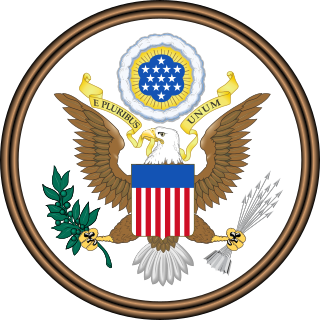 W
WThe Coast Guard Act of 1915 was passed by Congress on January 20, 1915, and signed into law by then-American president Woodrow Wilson on the twenty-eighth day of the same month. The act created the United States Coast Guard as a new service outwardly modeled on the structure of the U.S. Navy and under the command of the Department of Treasury.
 W
WThe Coast Guard Museum Northwest is dedicated to preserving the heritage of the United States Coast Guard in the Pacific Northwest. The museum is located on the property of Coast Guard Station Seattle on the Elliott Bay waterfront south of Downtown, Seattle, Washington. It covers the full range of Coast Guard roles, ranging from protecting shores, lives and property to lighthouses and lightships, from life-saving stations to rescue boats, from buoy tenders to icebreakers and weather ships and from modern aircraft to patrol boats and cutters. The museum admittance is free of charge.
 W
WMartha Jane Coston was an inventor and businesswoman best known for her invention of the Coston flare, a device for signaling at sea.
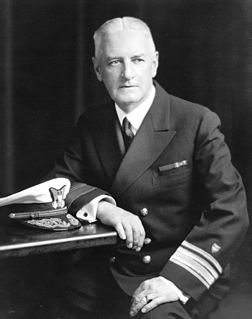 W
WThe Creed of the United States Coast Guardsman was written in 1938 by Vice Admiral Harry G. Hamlet, who served as Commandant of the Coast Guard from 1932 to 1936. According to former Commandant Robert Papp, the Creed described the duties and responsibilities that binds the group of Coast Guardsmen together as "shipmates".
 W
WDiamond Shoal Lightship No. 71 (LV-71) was a lightship of the United States Lighthouse Service. She is most remembered for her sinking in 1918 during World War I when a German U-boat attacked her off North Carolina. Her shipwrecked remains were listed on the National Register of Historic Places in 2015.
 W
WSS El Estero was a ship filled with ammunition that caught fire at dockside in New York Harbor in 1943, but was successfully moved away and sunk by the heroic efforts of tug boats and fireboats, averting a major disaster.
 W
WThe Ellenton Riot occurred in September of 1876. Author Mark M. Smith concluded that there was one white and up to 100 blacks killed, with several white people wounded.
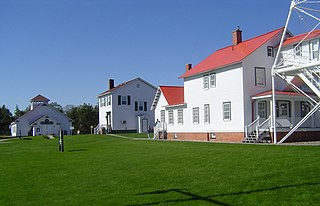 W
WThe Great Lakes Shipwreck Museum is located at the Whitefish Point Light Station 11 miles (18 km) north of Paradise in Chippewa County in the U.S. state of Michigan. The light station property was transferred to the Great Lakes Shipwreck Historical Society (GLSHS), the Michigan Audubon Society (MAS), and the United States Fish and Wildlife Service (USFWS) in 1996. The three entities share governance of the site. The museum is operated by the GLSHS. The museum exhibits artifacts from shipwrecks from the Whitefish Point Underwater Preserve and the bell from the wreck of the SS Edmund Fitzgerald. Admission to the museum includes a tour of historic buildings with displays that interpret the Great Lakes maritime, United States Coast Guard, and US Life-Saving Service history.
 W
WThe Greenland Patrol was a United States Coast Guard operation during World War II. The patrol was formed to support the U.S. Army building aerodrome facilities in Greenland for ferrying aircraft to the British Isles, and to defend Greenland with special attention to preventing German operations in the northeast. Coast Guard cutters were assisted by aircraft and dog sled teams patrolling the Greenland coast for Axis military activities. The patrol escorted Allied shipping to and from Greenland, built navigation and communication facilities, and provided rescue and weather ship services in the area from 1941 through 1945.
 W
WThe Ingham Incident, or the Montezuma Affair, was a naval battle fought in 1835, the first between Mexico and the United States. The Mexican warship Montezuma patrolled the coast of Texas to prevent the smuggling of contraband into the territory. During the cruise, the Mexicans captured the American merchant ship Martha and later the Texan ship Columbia which led to a response by the United States Revenue-Marine revenue cutter USRC Ingham. A bloodless engagement was fought on June 14, and ended when the Montezuma was purposely run aground to prevent capture.
 W
WThe United States Life-Saving Service was a United States government agency that grew out of private and local humanitarian efforts to save the lives of shipwrecked mariners and passengers. It began in 1848 and ultimately merged with the Revenue Cutter Service to form the United States Coast Guard in 1915.
 W
WThe United States Lighthouse Service, also known as the Bureau of Lighthouses, was the agency of the United States Government and the general lighthouse authority for the United States from the time of its creation in 1910 as the successor of the United States Lighthouse Board until 1939 when it was merged into the United States Coast Guard. It was responsible for the upkeep and maintenance of all lighthouses and lightvessels in the United States.
 W
WThe Military Sea Services Museum, located at 1402 Roseland Avenue, Sebring, Florida, developed from the ideas of the members of Branch 173 of the Fleet Reserve Association (FRA). The members discussed "displaying their memorabilia to 'dress up' the building and promote the military sea services.". The museum was established in 1998, with the "Grand Opening" occurring on Memorial Day, and contains artifacts and exhibits relating to the U.S. Coast Guard, U.S. Marines and U.S. Navy, including state flags, posters, military items, and sea services memorabilia.
 W
WThe Nathan F. Cobb was a three-masted schooner named after the shipbuilder and founder of Cobb's Salvaging Company whose many rescues of stranded ships help lead to the formation of the United States Life-Saving Service. Despite its namesake's history of shipwreck rescues, the Nathan F. Cobb capsized in heavy seas on 1 December 1896 en route from Brunswick, Georgia to New York with a cargo of timber and cross ties. The cook and a shipmate drowned when they were swept overboard in violent seas. The crew righted the vessel by removing the three masts and they drifted for four days until they became grounded on a sandbar off Ormond Beach, Florida. Rescue attempts led to the drowning of volunteer Fred Waterhouse, whose body was never recovered, but no other crew members were lost. A plaque commemorates Fred Waterhouse's rescue efforts. The Cobb Cottage, a structure built using materials salvaged from the ship, is part of Ormond Beach's Historic Trail.
 W
WThe New London riots of 1919 were a series of racial riots between white and black Navy sailors and Marines stationed in New London and Groton, Connecticut.
 W
WQuogue Life-Saving Station is a historic life-saving station located at Quogue in Suffolk County, New York. It was built in 1912 by the United States Life-Saving Service in the Shingle Style, as a replacement for a deteriorating 1849-built station. It is a 1 1⁄2-story gable-roofed structure. It features a 4-story, wood-shingled tower topped by a hipped roof.
 W
WThe Rum Patrol was an operation of the United States Coast Guard to interdict liquor smuggling vessels, known as "rum runners" in order to enforce prohibition in American waters. On 18 December 1917, the 18th Amendment to the Constitution was submitted to the states by Congress. On 16 January 1919, the amendment was ratified and the Liquor Prohibition Amendment, which prohibited the manufacture, sale, transportation, importation, or exportation of intoxicating liquors, came into effect on 16 January 1920.
 W
WSinbad was a mixed-breed dog that was one of two animals to be classified as non-commissioned officers by an arm of the United States military, rather than property, prior to the enactment of regulations to prohibit such after being enlisted by the creative crew of USCGC Campbell. Prior to and after an official retirement, Sinbad was assigned the title of Chief Dog, his rank being that of Chief Petty Officer. At the time of the biography written by George Foley, no other member of the United States Coast Guard had yet been the subject of a published biography. Sinbad spent 11 years at sea on the Campbell including combat in World War II that became widely publicized as part of the homefront campaign.
 W
WEdward Hanson "Iceberg" Smith was a United States Coast Guard admiral, oceanographer, and Arctic explorer. He was born 29 October 1889 at Vineyard Haven, Massachusetts. He received a Ph.D. in oceanography from Harvard, and commanded the USCGC Marion and the USCGC Northland. Most famously, he commanded the Greenland Patrol, and led Coast Guard efforts to defend Greenland against the Germans in World War II. After retirement from the Coast Guard, he assumed the directorship of Woods Hole Oceanographic Institution.
 W
WThe Steamboat Inspection Service was a United States agency created in 1871 to safeguard lives and property at sea. It merged with the Bureau of Navigation in 1932 to form the Bureau of Navigation and Steamboat Inspection which, in 1936, was reorganized into the Bureau of Marine Inspection and Navigation, which in turn came under the control of the United States Coast Guard in 1942 and was abolished, with its functions transferred to the Coast Guard, in 1946.
 W
WThe Two Hearted River is a river in the eastern Upper Peninsula of the U.S. state of Michigan.
 W
WThe U.S. Customshouse is a historic customs house and United States Coast Guard museum on Cobbs Hill at 3353 Main Street in Barnstable, Massachusetts. Built in 1855 to a design by Ammi Young, it was used as a custom house and post office until 1913, continuing to house the post office and other offices until 1958. It was converted into a museum in 1960, and was listed on the National Register of Historic Places in 1975.
 W
WThe United States Revenue Cutter Service was established by an act of Congress on 4 August 1790 as the Revenue-Marine upon the recommendation of Secretary of the Treasury Alexander Hamilton to serve as an armed customs enforcement service. As time passed, the service gradually gained missions either voluntarily or by legislation, including those of a military nature. It was generally referred to as the Revenue-Marine until 31 July 1894, when it was officially renamed the Revenue Cutter Service. The Revenue Cutter Service operated under the authority of the U.S. Department of the Treasury. On 28 January 1915, the service was merged by an act of Congress with the United States Life-Saving Service to form the United States Coast Guard.
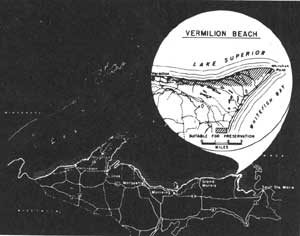 W
WVermilion Point is a remote, undeveloped shore in Chippewa County, Michigan, United States. Located 9.75 miles (15.69 km) west of Whitefish Point, Michigan, this historic spot lies on a stretch of Lake Superior’s southeast coast known as the "Graveyard of the Great Lakes" or the "Shipwreck Coast". The servicemen of Vermilion Lifesaving Station performed daring rescues of shipwrecks from 1877 until 1944 when it was closed after modern navigational technology made this service obsolete.
 W
WThe Virginia Beach Surf & Rescue Museum honors and preserves the history of Virginia's maritime heritage, coastal communities, the United States Lifesaving Service, and the United States Coast Guard along the Atlantic coast.